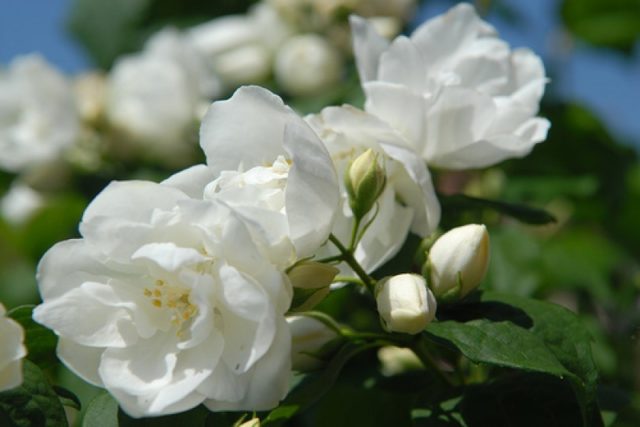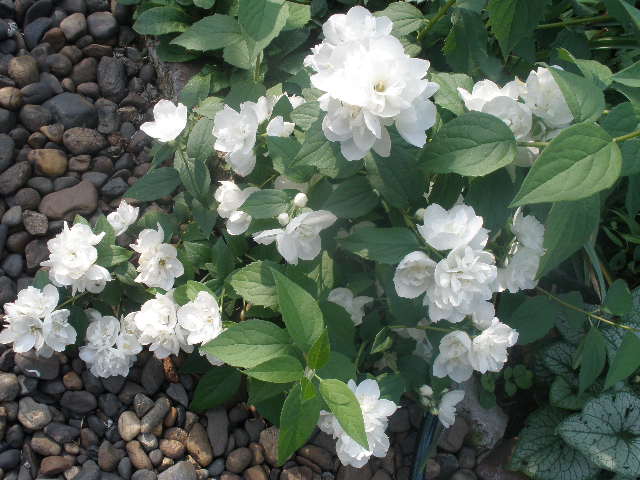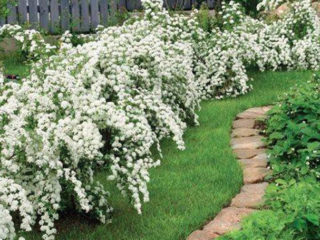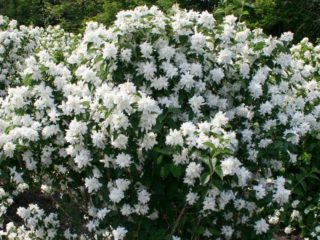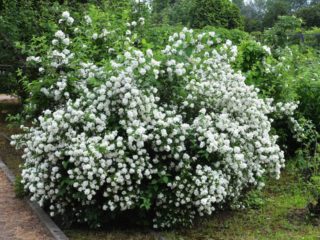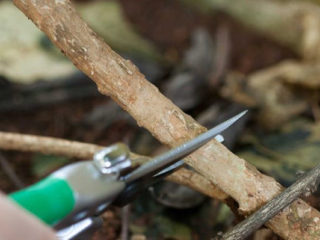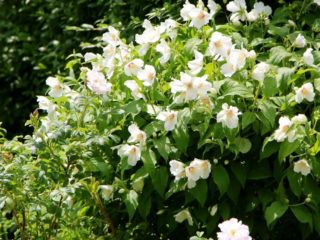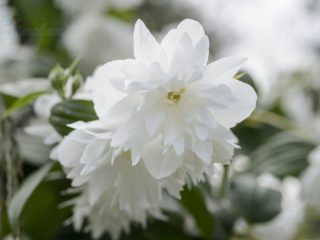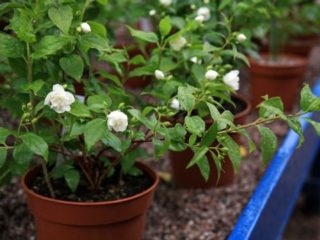Content
Mock orange Virgin is an ornamental deciduous shrub of the Hydrangeaceae family. It is unpretentious, hardy, has good growth rates and is immune to air pollution, which makes it possible to grow the plant within the city.
In Russia, a widespread misnomer for the shrub is jasmine. The confusion is caused by the similarities in appearance and aroma of the two crops.
Description of the mock orange Virgin
Mock orange (Philadelphus Virginal) is an old double variety of garden jasmine that can grow up to 2.5-3 m in height. The crown of the bush can reach 3 m in diameter, which gives it a rather lush and massive appearance.
The branches of this plant variety are erect, covered with dark green leaves. The leaf blade of the Virgin mock orange is smooth to the touch, the leaf length is on average 5-6 cm. By autumn the foliage turns yellow and falls off.The average annual growth of the variety reaches 30 cm.
How the Virgin mock orange blooms
Garden jasmine Virginal blooms in June, flowering continues until July. At the same time, one feature of the flowering of this variety should be mentioned - from year to year its flowers can change their shape. Double flowers are often replaced by simple ones and, vice versa, regardless of care.
The flowers of the mock orange variety Virginal are snow-white, as can be seen in the photo below. Their size reaches 5 cm in diameter. The inflorescences in which the flowers are collected can reach 10-12 cm in length.
The flowers of the Virgin variety smell like vanilla, however, many gardeners note the similarity with the aroma of an orange tree and real jasmine. As night approaches, the aroma intensifies.
Main characteristics
The Virgin variety is a cold-resistant species - it winters safely when the temperature drops to -25°C. Of course, it is still better to insulate the plant for the winter, especially in mid-latitudes and in the north of the country, since in particularly harsh winters the ends of the shoots can freeze.
The Virgin variety has good disease resistance; it hardly gets sick. Sometimes mock orange is affected by pests.
Features of reproduction
Virginal mock orange is usually propagated vegetatively:
- layering;
- dividing the bush;
- cuttings.
The easiest way to propagate Virgin mock orange is by layering. This process looks like this:
- In spring, a healthy shoot is selected from a bush and bent to the ground.
- The branch is securely fixed with a bracket and sprinkled with earth.
- In the fall, when the mock orange shoot takes root, it is transplanted to a new place.
Garden jasmine seeds of the Virgin variety are not bred. Firstly, this method is very labor-intensive. Secondly, it often leads to loss of varietal qualities.
Planting and caring for Virgin jasmine
Planting mock orange variety Virginia, as well as subsequent care of the shrub, usually does not cause any special problems. The plant is hardy and unpretentious; it takes root well in almost any type of soil. The only significant exception is soil with extremely high acidity levels.
Recommended timing
Mock orange seedlings with an open root system are planted in spring and autumn. Planting material with a clod of earth, grown in containers, can be planted throughout the season, but it is better to do this in the spring in central Russia and the north. Thus, the Virgin mock orange will have more time to settle down in a new place.
Site selection and soil preparation
The site for planting Virgin mock orange is selected taking into account the following recommendations:
- Garden jasmine of this variety loves the sun, so plantings are placed in well-lit areas. As a last resort, partial shade will do. In the shade, the flowers of the Virgin mock orange become very small.
- Garden jasmine prefers soils with good water conductivity.
- The high level of groundwater negatively affects the development of the Virgin mock orange variety.
- Too wet soils are also not good for the shrub. It is better not to plant it in wetlands.
If the soil is too heavy, it is dug up using a spade 2 weeks before planting the mock orange and diluted with sand.
Landing algorithm
When preparing a planting hole for Virgin garden jasmine, you should pay attention to the size of the mock orange root system, however, on average, the depth of the hole is 50 cm. The diameter of the hole should be within 50-60 cm.
The procedure for planting Virgin mock orange is as follows:
- A drainage layer is placed at the bottom of the planting hole. Suitable material for this: broken brick, expanded clay, pebbles, clay shards or just small stones. Regardless of the nature of the material, you can mix it with river sand. The thickness of the drainage layer should be 10-15 cm.
- The top of the drainage is sprinkled with a small amount of garden soil mixed with humus and sand in a ratio of 3:1:1. Additionally, the mixture is diluted with a small amount of nitrophoska.
- Then a mock orange seedling is lowered into the hole and its roots are covered with soil. It is important to ensure that the root collar is not below ground level.
- Immediately after planting, garden jasmine is recommended to be watered abundantly.
- After this, the area under the seedling is lightly compacted and mulched to a depth of 4-5 cm. Dry leaves, sawdust, peat or compost are used as mulch.
When planting in groups, the distance between two adjacent holes should be at least 2 m. In order to grow a hedge from mock orange seedlings, the seedlings are placed at a distance of 1-1.5 m from each other.
Growing rules
The rules for growing the Virgin mock orange variety are the most standard: for full development, the bush needs timely watering, 2-3 feedings per season and good shelter for the winter. If desired, garden jasmine is mulched, the soil is loosened and the ground around it is weeded.
Watering schedule
Garden jasmine of the Virgin variety develops best in moderately moist soils, so it is important to observe regular watering and a number of basic rules associated with this process:
- For watering Virgin mock orange, only water that has stood in the sun is suitable. Cold water cannot be used; it must warm up at least a little.
- Garden jasmine is watered about 2 times a week if the year is moderately hot. During the dry season, the frequency is increased to 3 times a week. If the season promises to be rainy, watering can be reduced to once a week. In case of particularly heavy rainfall it is stopped altogether. During the mock orange flowering period, it is watered every day.
- Each time after watering, it is recommended to slightly loosen the soil under the garden jasmine and renew the mulch layer.
Weeding, loosening, mulching
Loosening the soil is necessary in order to improve air permeability. It is especially important to carry out this procedure if, after watering or rain, the top layer of soil has become compacted and began to resemble a crust.
Mulching is carried out immediately after planting, using peat, sawdust or pine needles. This is done so that moisture remains in the soil longer after watering.
Weeding the soil is carried out as necessary if too many weeds grow under the bush. A small growth does not cause much harm to the mock orange.
Feeding schedule
The Virgin mock orange variety is fed only in the second year after planting in open ground.It is better not to apply fertilizers before this - they can cause burns to the root system of young, immature seedlings. On average, 2-3 feedings are applied per season.
In the spring, mock orange can be fed with organic fertilizers, and both mulching the tree trunk circle and fertilizing the soil are suitable.
The bush is fed the second time during the formation of buds. At this time, complex mineral fertilizers are used.
In the fall, organic matter is again used as fertilizing. This way, the mock orange will receive enough nutrients to survive the winter safely. If desired, instead of organic fertilizers, you can use phosphorus-potassium mixtures.
Trimming
In order for the bush to remain attractive and maintain its decorative appearance, it needs to be pruned from time to time. They do this in spring and autumn.
In the spring months, mock orange is examined immediately after the shelter is removed for the winter. All frozen or broken shoots are removed from the bush and branches that have strayed from the crown are slightly shortened.
In the fall, after flowering, all faded inflorescences should be removed from the Virgin mock orange. Additionally, it is necessary to thin out the shrub, since thickening the crown negatively affects its development - the leaves deep in the crown receive insufficient light, so the plant begins to weaken.
Preparing for winter
Garden jasmine Virginal is required to be covered in the north of the country and the middle zone, especially young plants. Mature plants are not so vulnerable to low temperatures. In the south of Russia, you don’t have to insulate mock orange trees at all before winter.
Preparing a shrub for wintering involves the following steps:
- The area under the bush is mulched with peat or any other suitable material.
- Then the mock orange branches are carefully tied up and the bush is wrapped in agrofibre.
- When precipitation begins to fall, the snow is raked up to the bush, using it as additional shelter from the wind and cold.
Pests and diseases
The description of the Virgin garden jasmine states that the variety rarely gets sick. This is confirmed by reviews from gardeners - the shrub does not require preventive treatments throughout the entire season, which greatly simplifies the process of growing this plant.
The Virgin variety is not as resistant to insects as it is to diseases. Quite often, plantings are affected by the following pests:
- bean aphid;
- spider mite;
- green leaf weevil.
To combat them, you can use industrial products (insecticides) or folk methods. The second option is preferable, since insecticides can harm the plant if the dosage is not correct. In order to get rid of insects, it is better to use various infusions and decoctions of herbs:
- wormwood;
- tansy;
- yarrow;
- dandelion;
- marigolds;
- tops of potatoes and tomatoes.
Conclusion
Mock orange Virgin is considered one of the most unpretentious and durable shrubs. The combination of the undemanding shrub, its high decorative qualities and pleasant rich aroma was the reason for its wide distribution.This garden crop can be grown without much difficulty not only by a professional in the field of gardening, but also by a complete beginner in this matter. Also, Virgin mock orange is an excellent garden decoration option for those who do not want to spend a lot of time caring for the garden. The plant needs very minimal care to maintain its attractive appearance.
You can learn more about the peculiarities of growing mock orange from the video below:
Reviews of mock orange Virgin
It's even better not to plant the plant in the shade. I planted one bush separately from the rest, in a different place, so it became quite weak in the shade.I'm planning to replant.
